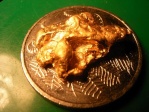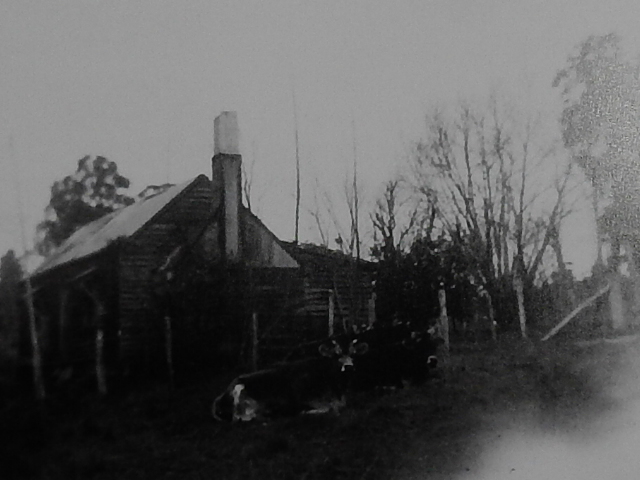The Reason for Round Holes in the Diggings rather than elongated Holes?
+4
llanbric
deutran
Minermike
PeterInSa
8 posters
Page 1 of 1
 The Reason for Round Holes in the Diggings rather than elongated Holes?
The Reason for Round Holes in the Diggings rather than elongated Holes?
During our recent trip to the Vic Triangle, I was interested to find what the early miners had missed in a diggings hole. One of the reasons why I had purchased the Z many years ago was to find deep gold in patches that we had found in the West on my next trip over ( Did not happen have never found deep gold in WA), The other reason was in Vic in a diggings hole to use the Z to look near the bottom of a hole, on the side of the hole to check adjacent ground not worked/dug out, by the original miner. In this instance I have had some success and quite a few non events.
I choose a diggings hole that was about 7ft wide at the top slightly elongated to around 9ft and about 6ft deep, this hole was central in the diggings that were around 100m wide at this point.
The dirt at the top had many piece of small quartz around the 1cm Cubic size. I raked the the leaves out of the hole and shoveled/dug the dirt out for another 1/3m, did not come across any of the same quartz as per the on the heap, just coloured quartz about the size of 1/3 of your fist, so my thinking at the time was I had dug below the quartz/gold level, in hindsight I should have dug horizontal to see if the ground there was similar to the dirt on top of the heap.
I estimate that the dirt taken out of this hole and others around it accounted for 3ft high of dirt, ie the hole to the gold was only dug down 3ft.
So the lead up to my question is. Why did'nt the miners in the old days link up the holes to get the gold in between?, on this field I only recall 2 elongated holes where 2 sets of holes were linked up.
Peter
I choose a diggings hole that was about 7ft wide at the top slightly elongated to around 9ft and about 6ft deep, this hole was central in the diggings that were around 100m wide at this point.
The dirt at the top had many piece of small quartz around the 1cm Cubic size. I raked the the leaves out of the hole and shoveled/dug the dirt out for another 1/3m, did not come across any of the same quartz as per the on the heap, just coloured quartz about the size of 1/3 of your fist, so my thinking at the time was I had dug below the quartz/gold level, in hindsight I should have dug horizontal to see if the ground there was similar to the dirt on top of the heap.
I estimate that the dirt taken out of this hole and others around it accounted for 3ft high of dirt, ie the hole to the gold was only dug down 3ft.
So the lead up to my question is. Why did'nt the miners in the old days link up the holes to get the gold in between?, on this field I only recall 2 elongated holes where 2 sets of holes were linked up.
Peter
PeterInSa- Contributor Plus

- Number of posts : 276
Registration date : 2018-11-05
 Re: The Reason for Round Holes in the Diggings rather than elongated Holes?
Re: The Reason for Round Holes in the Diggings rather than elongated Holes?
G’day PeterInSa,
The round holes you mentioned were most likely dug by Chinese and I think each hole dug would have been dug by different miners under different claims.
Cheers.
Mike.
The round holes you mentioned were most likely dug by Chinese and I think each hole dug would have been dug by different miners under different claims.
Cheers.
Mike.
Guest- Guest
 Re: The Reason for Round Holes in the Diggings rather than elongated Holes?
Re: The Reason for Round Holes in the Diggings rather than elongated Holes?
Hi Mike, this field of shallow diggings were all round holes except the 2, I mentioned. I understand deep round holes 20Ft Plus were Chinese compared to other rectangular of other nationalities..
Re agree on different adjacent holes dug by different Miners on different claims, but why not meet up and share the gold?
Re agree on different adjacent holes dug by different Miners on different claims, but why not meet up and share the gold?
PeterInSa- Contributor Plus

- Number of posts : 276
Registration date : 2018-11-05
 Re: The Reason for Round Holes in the Diggings rather than elongated Holes?
Re: The Reason for Round Holes in the Diggings rather than elongated Holes?
I’m pretty sure that the old timers didn’t take kindly to CLAIM JUMPERS.  Hence the big caliber slugs we often find. Also a lot of holes dug were a hit or miss, so they would try to bottom their hole as quickly as possible then move to the next hole.
Hence the big caliber slugs we often find. Also a lot of holes dug were a hit or miss, so they would try to bottom their hole as quickly as possible then move to the next hole.
Cheers.
Mike.
Cheers.
Mike.
Guest- Guest
 Re: The Reason for Round Holes in the Diggings rather than elongated Holes?
Re: The Reason for Round Holes in the Diggings rather than elongated Holes?
As an opal miner , we dug round holes with an air jack hammer in Andamooka and Opalton . You made a step in the hole and kept going around like a corkscrew . The diameter was usually the distance of the biggest guy from his bum to the top of his head when bent over ! Before drills in Coober Pedy , we sank rectangular holes using gelignite . The sand stone was harder and would have taken a lot longer to sink . I did see some German guys sink one with a jack hammer , about 60 feet on the Olympic Field .

Minermike- Contributor Plus

- Number of posts : 1595
Age : 80
Registration date : 2011-07-25
 Re: The Reason for Round Holes in the Diggings rather than elongated Holes?
Re: The Reason for Round Holes in the Diggings rather than elongated Holes?
I suspect many holes were speculative and only those few with significant finds were widened and linked in the process.Obviously the most efficient method moving the least amount of overburden was found over time.I guess they also had to find the direction of the lead in the process.

deutran- Contributor Plus

- Number of posts : 1841
Age : 60
Registration date : 2009-09-26
AnnieL likes this post
 Re: The Reason for Round Holes in the Diggings rather than elongated Holes?
Re: The Reason for Round Holes in the Diggings rather than elongated Holes?
From what I have read. The basic need was to get to bedrock in the most efficient way. A rectangular hole, about 600mm by 900mm was started, these dimensions are roughly that of a man bent over while using a short handled pick, the hole was continued until bedrock. When at bedrock the bottom of the hole was expanded following the bedrock to the extent of your claim. So we have a narrow shaft leading to an expanded bulb at the bottom, an inverted mushroom shaped.
Over the decades the bottom of the hole collapsed as did the soil above it, and was filled in, leaving a round hole at ground level.
Over the decades the bottom of the hole collapsed as did the soil above it, and was filled in, leaving a round hole at ground level.
llanbric- Contributor Plus

- Number of posts : 415
Registration date : 2008-11-17
AnnieL and moredeep like this post
 Re: The Reason for Round Holes in the Diggings rather than elongated Holes?
Re: The Reason for Round Holes in the Diggings rather than elongated Holes?
Re (I suspect many holes were speculative and only those few with significant finds were widened and linked in the process)
So in a run of diggings, its best to put the effort into the diggings in the center, to hopefully avoid the speculative diggings on the edges.
Re (So we have a narrow shaft leading to an expanded bulb at the bottom, an inverted mushroom shaped.
Over the decades the bottom of the hole collapsed as did the soil above it, and was filled in, leaving a round hole at ground level.)
Good point, thats probably why the Z finds rubbish on the bottom of the side walls, but some distances in, ie because of the inverted mushroom shape at the bottom.
Peter
So in a run of diggings, its best to put the effort into the diggings in the center, to hopefully avoid the speculative diggings on the edges.
Re (So we have a narrow shaft leading to an expanded bulb at the bottom, an inverted mushroom shaped.
Over the decades the bottom of the hole collapsed as did the soil above it, and was filled in, leaving a round hole at ground level.)
Good point, thats probably why the Z finds rubbish on the bottom of the side walls, but some distances in, ie because of the inverted mushroom shape at the bottom.
Peter
PeterInSa- Contributor Plus

- Number of posts : 276
Registration date : 2018-11-05
moredeep likes this post
 Re: The Reason for Round Holes in the Diggings rather than elongated Holes?
Re: The Reason for Round Holes in the Diggings rather than elongated Holes?
The round holes were probably close to a creek system (still wet or long dried out). Each hole tends to be around the same depth and circumference if dug trying to locate the alluvial bed. These shallow types of holes were 'test holes' that were sunk to try and determine where the ancient riverbed was located. If the hole bottomed out onto alluvial gold, they would often tunnel in between the holes giving up gold after they had cleaned the bottom out as best as they could where the bedrock was. But tunneling between holes in alluvial deposits is extremely dangerous. The loose material would often kill them by collapsing instantly... and a flash flood often drowned men in the Victorian diggings. The records in 1861 showed "none could swim" and "...drowned in a terrible way in their sinkholes, in liquid mud, unable to climb out to save themselves...". Tunneling through would also run the risk of running into other miners on adjacent claims. Hence, most of these shafts had few or no drives in their side-walls unless a large mining venture had the rights to dig the region.
Holes that were dug on the sides of hills and mountains that were in a line or following a specific direction, were usually dug by more experienced mining mining companies. These holes were usually much, much deeper and were often dug to try and intersect a known gold reef. It was a lot of work that usually resulted in disappointment.
Holes that were dug on the sides of hills and mountains that were in a line or following a specific direction, were usually dug by more experienced mining mining companies. These holes were usually much, much deeper and were often dug to try and intersect a known gold reef. It was a lot of work that usually resulted in disappointment.

nero_design- Contributor Plus

- Number of posts : 2090
Registration date : 2008-11-18
moredeep likes this post
 Re: The Reason for Round Holes in the Diggings rather than elongated Holes?
Re: The Reason for Round Holes in the Diggings rather than elongated Holes?
MinerMike.....Some years ago a small claim opal miner on the Kyabra field was pulling some beautiful harlequin pipe opal from a shaft and shallow drives.
His shaft was a slot, about 2' 6" wide by about 6' long and around 15' deep. Near one end he had cut staggered toe holes in the side walls about 18" above each other. He had a frame above his shaft with a knotted rope hanging down, his method was to hold and steady himself with the rope then use the toe holds like ladder rungs but with his feet spread across the shaft.
He followed the magnasite iron layer on the drive ceiling, wheeling his overburden out in a barrow. Would tip it into a drum, scurry up the shaft, wind the drum up, tip then down again all in a matter of minutes.
About 5 foot nothing, 8 stone wringing wet, probably over 70 in age but boy was he a fit old codger. Often wonder what happened to him, when not mining he lived in Charleville.
His pipe opal though was spectacular, 2-3" long, around the size of a pencil in a hard coating.
mike
His shaft was a slot, about 2' 6" wide by about 6' long and around 15' deep. Near one end he had cut staggered toe holes in the side walls about 18" above each other. He had a frame above his shaft with a knotted rope hanging down, his method was to hold and steady himself with the rope then use the toe holds like ladder rungs but with his feet spread across the shaft.
He followed the magnasite iron layer on the drive ceiling, wheeling his overburden out in a barrow. Would tip it into a drum, scurry up the shaft, wind the drum up, tip then down again all in a matter of minutes.
About 5 foot nothing, 8 stone wringing wet, probably over 70 in age but boy was he a fit old codger. Often wonder what happened to him, when not mining he lived in Charleville.
His pipe opal though was spectacular, 2-3" long, around the size of a pencil in a hard coating.
mike
boobook- Contributor Plus

- Number of posts : 328
Registration date : 2011-09-12
Nightjar, Travelergold and moredeep like this post
 Re: The Reason for Round Holes in the Diggings rather than elongated Holes?
Re: The Reason for Round Holes in the Diggings rather than elongated Holes?
On The Flat in Coober Pedy I have been down old timers shafts . They were all rectangular and had steps in the sides , in the middle of the shaft . I lived in a tent on The Flat for about 3 months , 1967 .
I have heard of guys that can go up and down drilled shafts without ropes or anything . I never saw it happen .
I have heard of guys that can go up and down drilled shafts without ropes or anything . I never saw it happen .
Last edited by Minermike on Fri Jul 03, 2020 1:35 pm; edited 1 time in total (Reason for editing : more info .)

Minermike- Contributor Plus

- Number of posts : 1595
Age : 80
Registration date : 2011-07-25
moredeep likes this post
 Re: The Reason for Round Holes in the Diggings rather than elongated Holes?
Re: The Reason for Round Holes in the Diggings rather than elongated Holes?
My Grandfather could do that. Scarey 
Grandfather and his Bull Rush mine in Bonang not far from the house in the 30s Other family members founded the Morning Star mine in the area.

The family home in Bonang.

And people today think they have it tough if they don't have a fridge, TV, mbl phone and Gameboy and a king size bed n central heating

Grandfather and his Bull Rush mine in Bonang not far from the house in the 30s Other family members founded the Morning Star mine in the area.

The family home in Bonang.

And people today think they have it tough if they don't have a fridge, TV, mbl phone and Gameboy and a king size bed n central heating

adrian ss- Contributor Plus

- Number of posts : 4427
Age : 78
Registration date : 2015-07-03
Nightjar, AnnieL and moredeep like this post
 Re: The Reason for Round Holes in the Diggings rather than elongated Holes?
Re: The Reason for Round Holes in the Diggings rather than elongated Holes?
I did know Joe Vida ,a Frenchman , in Coober Pedy . He was a very good welder/engineer , he built many drilling rigs and underground mining machines . I did see his rotating , circular , double bed . It was hooked up to an electric motor and rotated all night !

Minermike- Contributor Plus

- Number of posts : 1595
Age : 80
Registration date : 2011-07-25
moredeep likes this post
 The round holes
The round holes
Apparently the "celestials" as the diggers called them would only dig round holes because of their belief that evil spirits would lurk in corners of the holes.
Diggers did drive sideways but you must remember that the average size of a claim back then was about 8-12 feet square so by the time you took out the rubbish to get to the gold bearing wash the area was soon filled up.
Oh, and if you encroached on your neighbour's claim he would probably shoot you!


Cheers
Robert
Diggers did drive sideways but you must remember that the average size of a claim back then was about 8-12 feet square so by the time you took out the rubbish to get to the gold bearing wash the area was soon filled up.
Oh, and if you encroached on your neighbour's claim he would probably shoot you!
Cheers
Robert

goldnomad- Contributor Plus

- Number of posts : 560
Age : 75
Registration date : 2012-05-29
moredeep likes this post
 Similar topics
Similar topics» Another reason to use Speakers rather than Headphones
» Anywhere (within reason) outside Canberra for gold detecting
» Do u put your coil into/over holes dug by others
» old watering holes
» RE; FILLING HOLES
» Anywhere (within reason) outside Canberra for gold detecting
» Do u put your coil into/over holes dug by others
» old watering holes
» RE; FILLING HOLES
Page 1 of 1
Permissions in this forum:
You cannot reply to topics in this forum